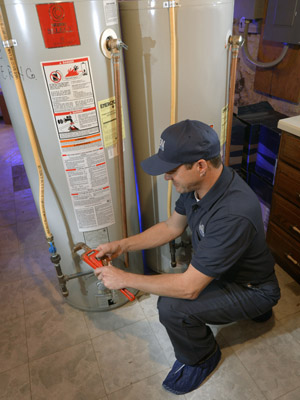 An anatomy, by definition, is a study of a something’s internal workings or structure. An anatomy of a water heater, therefore, is a study of how a water heater’s internal functions work. By understanding how your water heater works, you’ll have a better understanding of how to keep it working.
An anatomy, by definition, is a study of a something’s internal workings or structure. An anatomy of a water heater, therefore, is a study of how a water heater’s internal functions work. By understanding how your water heater works, you’ll have a better understanding of how to keep it working.
The water that enters your home takes a while to get there. It has to travel through the city’s pipes before coming to yours. Depending on the time of year, it’s typically cool or cold until it’s processed through your water heater. Most water heaters are large metal cylinders located in basements or closets. There are some modern tankless water heaters that work differently, but they’re still fairly new and uncommon. Without water heaters, we’d be forced to live a life of chilly showers and cold laundry.
That said: we already know how useful they are. Now it’s time to find out how they work.
How do water heaters work?
There are a variety of water heater types currently on the market. Today we’ll cover the two that are most common in Tampa homes: Traditional electric and gas water heaters. At first glance, these two varieties have a lot in common. They both have drain valves, TPR valves, an internal anode rod, dip tube, and similar pipe fittings. They’re both internally insulated to help preserve water temperature. At their simplest, they’re both basically large cylindrical tanks with an internal heating element.
Electric water heaters
Electric water heaters have a thermostat mounted flush with the outside of an internal tank. This thermostat constantly senses the internal temperature of the tank. If it senses the temperature getting too low, it starts the heating element inside the tank. The tank’s internal heating element heats up the water stored in the tank. The heating works the same way an electric range heats up a pot of water. Once the water reaches the set temperature, the thermostat cuts off power to the heating element.
Gas water  heaters
heaters
Gas water heaters have a thermostat just like electric ones do. The way this thermostat works is a bit different, however. The thermostats in gas water heaters contain a mercury sensor in the tip alongside a thermocouple. The thermocouple monitors the pilot light and the mercury sensor monitors the internal water temperature.
When the temperature inside the tank gets too low, the thermostat sends a signal to the gas control valve. This valve checks in with the thermocouple to make sure the pilot light is on. If it is, the valve opens and allows gas into a burner, igniting a flame. This flame heats the water. Once the water in the tank heats to the preferred temperature, the gas control valve closes again.
How to choose the right water heater for your home?
Start by checking out our helpful guide! We’ll cover everything you need to consider when choosing a new water heater. That includes the right type, fuel, efficiency, and tank size to fit your needs.
How do I best maintain my water heater?
- Make sure your drain the tank regularly to clear out any sediment build-up. If you don’t, sediment buildup in the tank will make the heater far less efficient.
- Set the water heater thermostat’s temperature to 120 degrees Fahrenheit or less. If you ever leave home for an extended period of time, consider turning the temperature down before you leave.
- Always keep an eye out for pooling water around the base of the heater’s tank. Catching small leaks before they become big ones will help save you a lot of money and trouble.
 Have a Water Heater Issue? Call Cass Plumbing
Have a Water Heater Issue? Call Cass Plumbing
If you’re interested in upgrading your Tampa home’s current water heater, give the team at Cass Plumbing a call. Our water heater experts can help you choose the right make, model, and size for your home. Not only that, but we can install as quickly and efficiently as possible.






